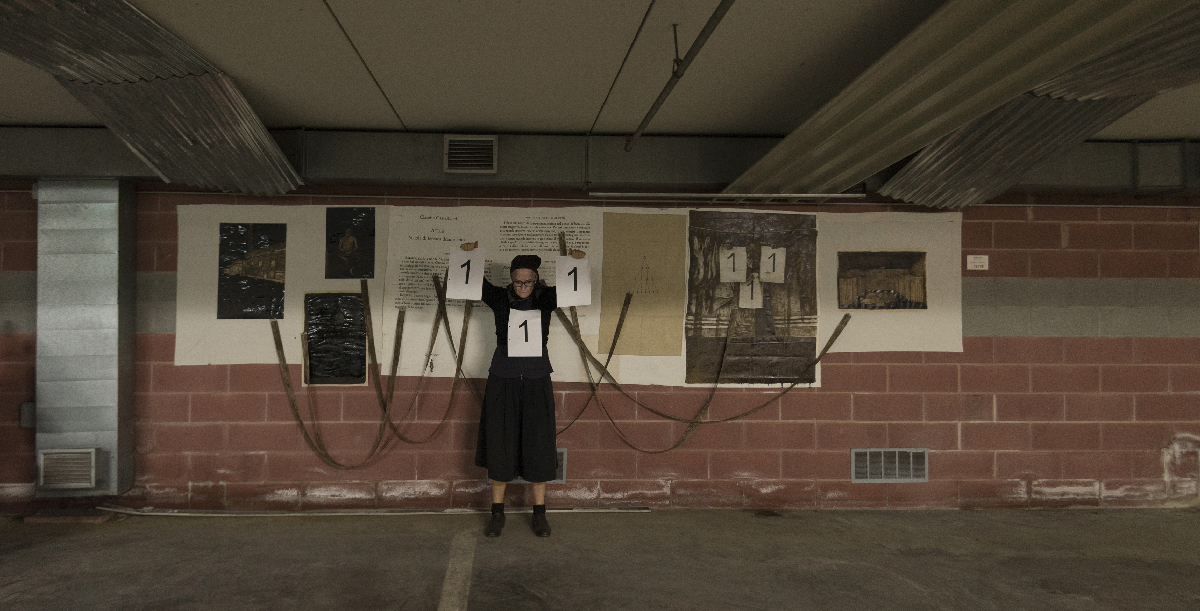The MAN Museum, in collaboration with the Municipality of Gavoi, presents the second stage of Sect. Behavior frameworks, a personal thematic of Claudia Castellucci curated by Silvia Fanti, in collaboration with the Marino Marini Museum of Florence. Until August 30th, the Gavoi Municipal Museum (formerly Casa Lai) welcomes a series of works created since 1985, along a path that revolves around Representation, crossing sculpture, stage action, language .
Artist, dancer and teacher , Claudia Castellucci has composed dramatic and theoretical texts, as well as having been an interpreter in many shows of the Socìetas Raffaello Sanzio, crossing and forcing different systems of representation, and created several dramatic schools and rhythmic, combining gymnastics with a philosophical practice. His personal research path, after thirty years of experience, resulted in the composition of Sect. School of dramatic technique, book/manual that presents 59 days of exercises, and useful indexes for reformulating the days. Socìetas Raffaello Sanzio is one of the most well-known and appreciated theater companies on the world scene. Romeo Castellucci, who founded it in 1981 together with Claudia Castellucci, Chiara Guidi and Paolo Guidi, received the Golden Lion of the Venice Biennale in 2013.
The book Sect. School of dramatic technique it is characterized by a transparent and declared purpose (the school) and by a structure intimately connected to this purpose (the exercises and the days). The schools (those she directed from 1989 to 2011, and potential future ones) are actually a dimension of knowledge , not a hub in its transmission. Indeed, with an “anathema” the author warns anyone who practices these exercises to frame them in a canonical method. As Claudia Castellucci writes “the indications contained in this book do not ask to be meditated on, but rather practiced. This practice is aimed at foundation of a way of being together : the school. The book establishes a school if at least three people decide to put it into practice. Dramatic technique is the area used by this school to competitively understand reality, therefore it is only a means and not the purpose of this school. The book’s ambition is to be used as a useful tool for developing a school. The revolutionary character of the scholastic relationship, which flourished in Mediterranean antiquity, assigns an importance to the way of knowing together that prevails over the knowledge of the disciplines itself. This way is done by doing exercises. You choose a relationship that serves to promote your knowledge; you don’t simply follow a person. This book’s attempt is to facilitate this relationship. It will then be discovered that even the place is not essential.”
The exhibition Sect. Behavior frameworks, is the implementation of the book. The works suggest what to do, they are a behavioral handbook . As Castellucci herself explains in hers Notes for didactic art : “I decided to explain the contents of my book through a series of captions. I choose the explanation, and not the theory, as in the book. I invite critics to the theory. There are practical thoughts: exercises that serve to found a real school, just as the decisions that are made regarding contact with it are real. The works I make are all, in one way or another, didactic. Technique and subject matter are also useful for learning. I don’t want to express a theory, but to invite praxis . However, praxis is a domain of a metaphysical order that distances utilitarianism and the utilitarian: only the useful accepts. This art, the art that accepts this order, is an art that serves.”
Claudia Castellucci was born in Cesena in 1958. He completed his studies at the Liceo Artistico and the Academy of Fine Arts in Bologna. In 1981 he participated in the foundation of Socìetas Raffaello Sanzio, for which he composed dramatic and theoretical texts, and with which he performed in the theaters of the main capitals of the world. At the same time he created rhythmic schools, some of which were dedicated to dance and others to the study of representation. Since 2009 he has divided his art into two branches: one delves into dance, as a discipline of time practiced by expert dancers, the other continues the idea of school as a work made of relationships. He continues to recite autographed texts sporadically, including the recent ones The Slave Dialogue And The Deep Realm . Published Mouth egg. Lyrical and dramatic writings, Bollati Boringhieri, 2000 e Sect. School of dramatic technique, Quodlibet, 2015.
Municipal Museum – Gavoi (Nu)
Via Margherita sn
From Friday to Sunday
10.00 am – 1.00 pm | 5.00pm – 8.00pm
For information:
MAN Museum
via S. Satta 27 – 08100 Nuoro
tel. +39 0784 25 21 10
info@museoman.it
www.museoman.it


